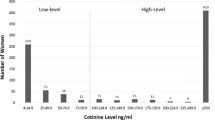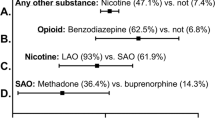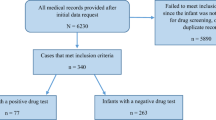Abstract
Objective:
We undertook this study to assess the agreement between fetal umbilical cord drug levels and maternal self-report.
Study Design:
Cord samples were collected from 103 placentas after delivery as a subproject of the larger Pacific Research Center for Early Human Development (PRCEHD) study. These cord samples were then processed to obtain cord lysates and enzyme-linked immunosorbent assay (ELISA) performed for cotinine and illicit drugs. Levels of each of these substances were compared with clinical information.
Result:
We found fair agreement between self-reported smoking and cotinine levels (κ=0.26 (0.07 to 0.5)) as well as slight agreement with current drug use and positive drug levels (κ=0.19 (−0.05 to 0.4)). Compared with maternal self-report, sensitivity of cotinine levels was 27% and specificity was 98%. Sensitivity of positive cord illicit drug levels was 32% and specificity was 85%.
Conclusion:
Umbilical cords provide another independent measure of maternal drug use and are readily available. To our knowledge, this is the first study to measure cotinine levels in the umbilical cord tissue.
This is a preview of subscription content, access via your institution
Access options
Subscribe to this journal
Receive 12 print issues and online access
$259.00 per year
only $21.58 per issue
Buy this article
- Purchase on Springer Link
- Instant access to full article PDF
Prices may be subject to local taxes which are calculated during checkout
Similar content being viewed by others
References
American College of Obstetricians and Gynecologists. ACOG Committee Opinion No. 422: at-risk drinking and illicit drug use: ethical issues in obstetric and gynecologic practice. Obstet Gynecol 2008; 112 (6): 1449–1460.
El-Mohandes A, Herman AA, Nabil El-Khorazaty M, Katta PS, White D, Grylack L . Prenatal care reduces the impact of illicit drug use on perinatal outcomes. J Perinatol 2003; 23 (5): 354–360.
Racine A, Joyce T, Anderson R . The association between prenatal care and birth weight among women exposed to cocaine in New York City. JAMA 1993; 270 (13): 1581–1586.
Broekhuizen FF, Utrie J, Van Mullem C . Drug use or inadequate prenatal care? Adverse pregnancy outcome in an urban setting. Am J Obstet Gynecol 1992; 166 (6 Pt 1): 1747–1754; discussion 54–56.
Bertrand J . Interventions for children with fetal alcohol spectrum disorders (FASDs): overview of findings for five innovative research projects. Res Dev Disabil 2009; 30 (5): 986–1006.
Field TM, Scafidi F, Pickens J, Prodromidis M, Pelaez-Nogueras M, Torquati J et al. Polydrug-using adolescent mothers and their infants receiving early intervention. Adolescence 1998; 33 (129): 117–143.
Gray TR, LaGasse LL, Smith LM, Derauf C, Grant P, Shah R et al. Identification of prenatal amphetamines exposure by maternal interview and meconium toxicology in the Infant Development, Environment and Lifestyle (IDEAL) study. Ther Drug Monit 2009; 31 (6): 769–775.
Montgomery D, Plate C, Alder SC, Jones M, Jones J, Christensen RD . Testing for fetal exposure to illicit drugs using umbilical cord tissue vs meconium. J Perinatol 2006; 26 (1): 11–14.
Montgomery DP, Plate CA, Jones M, Jones J, Rios R, Lambert DK et al. Using umbilical cord tissue to detect fetal exposure to illicit drugs: a multicentered study in Utah and New Jersey. J Perinatol 2008; 28 (11): 750–753.
Smith PK, Krohn RI, Hermanson GT, Mallia AK, Gartner FH, Provenzano MD et al. Measurement of protein using bicinchoninic acid. Anal Biochem 1985; 150 (1): 76–85.
Cohen J . A coefficient of agreement for nominal scales. Educ Psychol Meas 1960; 20 (1): 37–46.
Wright TE, Tam E . Disparate rates of persistent smoking and drug use during pregnancy of women of Hawaiian ancestry. Ethn Dis 2010; 20 (1 Suppl 1) S1-215-8.
Lantz CA, Nebenzahl E . Behavior and interpretation of the kappa statistic: resolution of the two paradoxes. J Clin Epidemiol 1996; 49 (4): 431–434.
Kliman H . The umbilical cord. In: Ernst Knobil JN (ed). The Encyclopedia of Reproduction. Elsevier Press: Maryland Heights, MO, 1998.
Derauf C, Katz AR, Easa D . Agreement between maternal self-reported ethanol intake and tobacco use during pregnancy and meconium assays for fatty acid ethyl esters and cotinine. Am J Epidemiol 2003; 158 (7): 705–709.
Schneider H, Panigel M, Dancis J . Transfer across the perfused human placenta of antipyrine, sodium and leucine. Am J Obstet Gynecol 1972; 114 (6): 822–828.
Schenker S, Yang Y, Johnson RF, Downing JW, Schenken RS, Henderson GI et al. The transfer of cocaine and its metabolites across the term human placenta. Clin Pharmacol Ther 1993; 53 (3): 329–339.
Simone C, Derewlany LO, Oskamp M, Knie B, Koren G . Transfer of cocaine and benzoylecgonine across the perfused human placental cotyledon. Am J Obstet Gynecol 1994; 170 (5 Pt 1): 1404–1410.
Luck W, Nau H, Hansen R, Steldinger R . Extent of nicotine and cotinine transfer to the human fetus, placenta and amniotic fluid of smoking mothers. Dev Pharmacol Ther 1985; 8 (6): 384–395.
Chasnoff IJ, Williams S, Sasaki D . The First 1,000 Women; Perinatal Substance Use on the Hawaii Island. Children's Research Triangle: Chicago, IL, 2010.
Hornby PJ, Abrahams TP . Pulmonary pharmacology. Clin Obstet Gynecol 1996; 39 (1): 17–35.
Lacy BW, Ditzler TF, Wilson RS, Martin TM, Ochikubo JT, Roussel RR et al. Regional methamphetamine use among U.S. Army personnel stationed in the continental United States and Hawaii: a six-year retrospective study (2000–2005). Mil Med 2008; 173 (4): 353–358.
Acknowledgements
This work was supported by grants from the National Institutes of Health (5 K24 HD01315-02 and 2 U 54 RR014607-06 from the Research Centers in Minority Institutions program in the National Center for Research Resources and CRECD in minority institutions 1 R25 RR019321).
Author information
Authors and Affiliations
Corresponding author
Ethics declarations
Competing interests
The authors declare no conflict of interest.
Rights and permissions
About this article
Cite this article
Wright, T., Milam, K., Rougee, L. et al. Agreement of umbilical cord drug and cotinine levels with maternal self-report of drug use and smoking during pregnancy. J Perinatol 31, 324–329 (2011). https://doi.org/10.1038/jp.2010.132
Received:
Revised:
Accepted:
Published:
Issue Date:
DOI: https://doi.org/10.1038/jp.2010.132
Keywords
This article is cited by
-
Systematic Review: Polysubstance Prevalence Estimates Reported during Pregnancy, US, 2009–2020
Maternal and Child Health Journal (2023)
-
Protective placental inflammatory and oxidative stress responses are attenuated in the context of twin pregnancy and chorioamnionitis in assisted reproduction
Journal of Assisted Reproduction and Genetics (2022)
-
Study protocol: Asking QUestions about Alcohol in pregnancy (AQUA): a longitudinal cohort study of fetal effects of low to moderate alcohol exposure
BMC Pregnancy and Childbirth (2014)
-
Translational toxicology: a developmental focus for integrated research strategies
BMC Pharmacology and Toxicology (2013)
-
Umbilical cord blood cotinine and smoking during pregnancy
Journal of Perinatology (2012)



